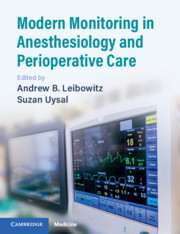Book contents
- Modern Monitoring in Anesthesiology and Perioperative Care
- Modern Monitoring in Anesthesiology and Perioperative Care
- Copyright page
- Contents
- Contributors
- Preface
- Chapter 1 Statistics Used to Assess Monitors and Monitoring Applications
- Chapter 2 Multimodal Neurological Monitoring
- Chapter 3 Cerebral Oximetry
- Chapter 4 The Oxygen Reserve Index
- Chapter 5 Point-of-Care Transesophageal Echocardiography
- Chapter 6 Point-of-Care Transthoracic Echocardiography
- Chapter 7 Point-of-Care Lung Ultrasound
- Chapter 8 Point-of-Care Ultrasound: Determination of Fluid Responsiveness
- Chapter 9 Point-of-Care Abdominal Ultrasound
- Chapter 10 Noninvasive Measurement of Cardiac Output
- Chapter 11 Assessing Intravascular Volume Status and Fluid Responsiveness: A Non-Ultrasound Approach
- Chapter 12 Assessment of Extravascular Lung Water
- Chapter 13 Point-of-Care Hematology
- Chapter 14 Assessment of Intraoperative Blood Loss
- Chapter 15 Respiratory Monitoring in Low-Intensity Settings
- Chapter 16 The Electronic Health Record as a Monitor for Performance Improvement
- Chapter 17 Future Monitoring Technologies: Wireless, Wearable, and Nano
- Chapter 18 Downside and Risks of Digital Distractions
- Index
- Plate Section (PDF Only)
- References
Chapter 10 - Noninvasive Measurement of Cardiac Output
Published online by Cambridge University Press: 28 April 2020
- Modern Monitoring in Anesthesiology and Perioperative Care
- Modern Monitoring in Anesthesiology and Perioperative Care
- Copyright page
- Contents
- Contributors
- Preface
- Chapter 1 Statistics Used to Assess Monitors and Monitoring Applications
- Chapter 2 Multimodal Neurological Monitoring
- Chapter 3 Cerebral Oximetry
- Chapter 4 The Oxygen Reserve Index
- Chapter 5 Point-of-Care Transesophageal Echocardiography
- Chapter 6 Point-of-Care Transthoracic Echocardiography
- Chapter 7 Point-of-Care Lung Ultrasound
- Chapter 8 Point-of-Care Ultrasound: Determination of Fluid Responsiveness
- Chapter 9 Point-of-Care Abdominal Ultrasound
- Chapter 10 Noninvasive Measurement of Cardiac Output
- Chapter 11 Assessing Intravascular Volume Status and Fluid Responsiveness: A Non-Ultrasound Approach
- Chapter 12 Assessment of Extravascular Lung Water
- Chapter 13 Point-of-Care Hematology
- Chapter 14 Assessment of Intraoperative Blood Loss
- Chapter 15 Respiratory Monitoring in Low-Intensity Settings
- Chapter 16 The Electronic Health Record as a Monitor for Performance Improvement
- Chapter 17 Future Monitoring Technologies: Wireless, Wearable, and Nano
- Chapter 18 Downside and Risks of Digital Distractions
- Index
- Plate Section (PDF Only)
- References
Summary
Since the combination of thermodilution with the balloon-tipped pulmonary arterial catheter by Swan and Ganz in the 1970s, researchers and clinicians have pursued the measurement and optimization of cardiac output to improve outcomes both in the operating room and the intensive care unit. Complications related to the invasiveness of this device have driven exploration of new methods to acquire the same information without the deleterious side effects, with mixed results. We will discuss several of these devices, the physical principles underlying their measurements, their relative accuracy compared to clinical and experimental standards, and clinical advantages and disadvantages of each device.
Keywords
- Type
- Chapter
- Information
- Modern Monitoring in Anesthesiology and Perioperative Care , pp. 100 - 108Publisher: Cambridge University PressPrint publication year: 2020

